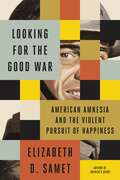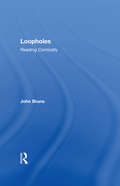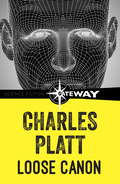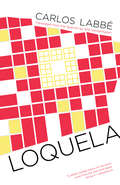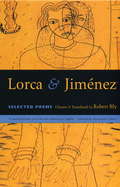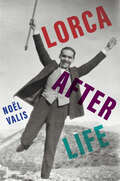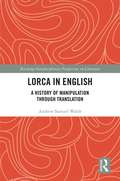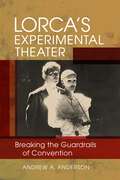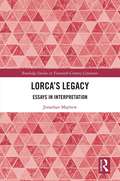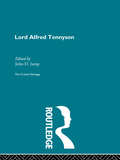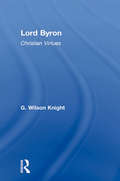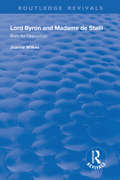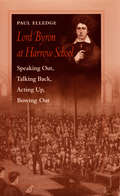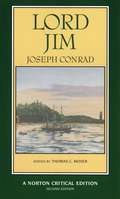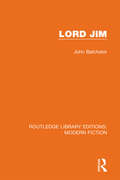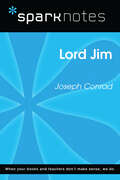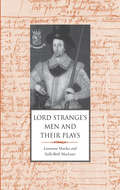- Table View
- List View
Looking for the Good War: American Amnesia and the Violent Pursuit of Happiness
by Elizabeth D. Samet"Essential reading. This eloquent, far-ranging analysis of the national psyche goes as far as any book I've ever read toward explaining the peculiar American yen for war and more war." —Ben Fountain, author of Billy Lynn's Long Halftime Walk and Beautiful Country Burn AgainIn Looking for the Good War, Elizabeth D. Samet reexamines the literature, art, and culture that emerged after World War II, bringing her expertise as a professor of English at West Point to bear on the complexity of the postwar period in national life. She exposes the confusion about American identity that was expressed during and immediately after the war, and the deep national ambivalence toward war, violence, and veterans—all of which were suppressed in subsequent decades by a dangerously sentimental attitude toward the United States’ “exceptional” history and destiny. Samet finds the war's ambivalent legacy in some of its most heavily mythologized figures: the war correspondent epitomized by Ernie Pyle, the character of the erstwhile G.I. turned either cop or criminal in the pulp fiction and feature films of the late 1940s, the disaffected Civil War veteran who looms so large on the screen in the Cold War Western, and the resurgent military hero of the post-Vietnam period. Taken together, these figures reveal key elements of postwar attitudes toward violence, liberty, and nation—attitudes that have shaped domestic and foreign policy and that respond in various ways to various assumptions about national identity and purpose established or affirmed by World War II.As the United States reassesses its roles in Afghanistan and the Middle East, the time has come to rethink our national mythology: the way that World War II shaped our sense of national destiny, our beliefs about the use of American military force throughout the world, and our inability to accept the realities of the twenty-first century’s decades of devastating conflict.
Loopholes: Reading Comically (Humor Studies)
by John BrunsMuch writing about comedy in the last twenty years has only trivialized comedy as cheap or as temporary distraction from things that "really matter." It has either presented exhaustive taxonomies of kinds of humor--like wit, puns, jokes, humor, satire, irony--or engaged in pointless political endgames, moral dialogues, or philosophical perceptions. Comedy is rarely presented as a mode of thought in its own right, as a way of understanding, not something to be understood.Bruns' guiding assumption is that comedy is not simply a literary or theatrical genre, to be diff erentiated from tragedy or from romance, but a certain way of disclosing, perhaps undoing, the way the world is organized. When we view the world in terms of what is incompatible, we are reading comically. In this sense, comedy exists outside the alternatives of tragic and comic.Loopholes argues that trivialization of comedy comes from fear that it will address our anxieties with honesty-- and it is this truth that scares us. John Bruns discusses comedy as a mode of thought with a cognitive function. It is a domain of human understanding, a domain far more troubling and accessible than we care to acknowledge. To "read comically" we must accept our fears. If we do so, we will realize what Bruns refers to as the most neglected premise of comedy, that the world itself is a loophole--both incomplete and limitless.
Loose Canon
by Charles PlattLoose Canon assembles thirty-four essays and reviews and associated texts - originally published in Interzone, Science Fiction Eye, New York Review of Science Fiction, The Magazine of Fantasy and Science Fiction, among other sources - from the early 1980s to the end of the 1990s.
Loose-leaf Version for Focus on Writing: Paragraphs and Essays
by Laurie G. Kirszner Stephen R. MandellFocus on Writing offers students clear, thorough coverage of writing college paragraphs and essays in a visually inviting format and with a unique tool for assessing and revising writing: the easy-to-grasp, easy-to-remember TEST method. Reinforcing the most important elements in academic writing--Topic sentence or Thesis statement, Evidence, Summary statement, and Transitions--this practical tool helps students self-edit their writing for unity, support, and coherence. In this edition, best-selling authors Laurie Kirszner and Stephen Mandell have added even stronger support for academic and college success with a new introduction "How Writing Can Help You Succeed" and a new appendix chapter on Strategies for College Success.
Loose-leaf Version for Media & Culture: An Introduction to Mass Communication
by Richard Campbell Ron Becker Christopher Martin Bettina Fabos<p>How well do you understand media as it is today?</p><p>We all know media is continually changing, which makes it important to know how it all works. With fake news and disinformation schemes, how you read and interpret media, in any source, can make a difference. Get to the heart of the matter by exploring the media landscape as it is today, but also seeing where it all came from with the up-to-date research and examples within Media & Culture, 13e.</p><p>From TikTok influencers and Twitter politics to streaming TV and digital deepfakes, Media & Culture, 13e helps you understand the connection between the mass media and today’s most significant trends. The text’s coverage of cutting-edge topics—everything from citizen journalism and 5G to Animal Crossing and Tiger King—makes succeeding in your mass communication course informative, interesting, and entertaining.</P>
Loquela
by Will Vanderhyden Carlos Labbé"Begins to fuck with your head from its very first word."--Toby Litt"Navidad & Matanza could be the hallucinogenic amalgamation of a César Aira plot with setting and characters conceived by Bolaño--if written using Oulipo-style constraints. . . . With ample imagination and commanding style, Navidad & Matanza certainly marks Labbé as a young author from whom we ought to anticipate great, fascinating things to come."--Jeremy Garber, Powell's BooksLoquela, Carlos Labbé's fourth novel and second to be translated into English, is a narrative chameleon, a shape-shifting exploration of fiction's possibilities.At a basic level, this is a distorted detective novel mixed with a love story and a radical statement about narrative art. Beyond the silence that unites and separates Carlos and Elisa, beyond the game that estranges the albino girls, Alicia and Violeta, from pleasant summer evenings, beyond the destiny of Neutria--a city that disappears with childhood--and beyond a Chilean literary movement that could be the last vanguard, while at the same time the greatest falsification, questions arise concerning who truly writes for whom in a novel--the author or the reader.Through an array of voices, overlapping storylines, a kaleidoscope of literary references, and a delirious, precise prose, Labbé carves out a space for himself among such great form-defying Latin American writers as Juan Carlos Onetti and Jorge Luis Borges.Carlos Labbé, one of Granta's "Best Young Spanish-Language Novelists," was born in Chile and is the author of a collection of short stories and six novels, one of which, Navidad & Matanza, is available in English from Open Letter. In addition to his writings, he is a musician, and has released three albums. Will Vanderhyden received an MA in literary translation from the University of Rochester.
Lorca & Jimenez: Selected Poems
by Robert BlyA unique gathering of poems by two great twentieth-century poets, with the original Spanish versions and powerful English translations on facing pages. In a new preface, editor and translator Robert Bly explores what the poems reveal today about politics, the spirit, and the purpose of art.
Lorca After Life
by Noel ValisA reflection on Federico García Lorca’s life, his haunting death, and the fame that reinvigorated the marvelous in the modern world “A galaxy of critical insights into the cultural shock waves circling and crisscrossing Lorca’s execution and his unknown resting place, there is not a single book on Lorca like this one.”—Andrés Zamora, Vanderbilt University There is something fundamentally unfinished about the life and work of Federico García Lorca (1898–1936), and not simply because his life ended abruptly. Noël Valis reveals how this quality gives shape to the ways in which he has been continuously re-imagined since his death. Lorca’s execution at the start of the Spanish Civil War was not only horrific but transformative, setting in motion many of the poet’s afterlives. He is intimately tied to both an individual and a collective identity, as the people’s poet, a gay icon, and fabled member of a dead poets’ society. The specter of his violent death continues to haunt everything connected to Lorca, fueling the desire to fill in the gaps in the poet’s biography.
Lorca in English: A History of Manipulation through Translation (Routledge Interdisciplinary Perspectives on Literature)
by Andrew Samuel WalshLorca in English examines the evolution of translations of Federico García Lorca into English as a case of rewriting and manipulation through politically and ideologically motivated translation. As new translations of Federico García Lorca continue to appear in the English-speaking world and his literary reputation continues to be rewritten through these successive re-translations, this book explores the reasons for this constant desire to rewrite Lorca since the time of his murder right into the 21st century. From his representation as the quintessential Spanish Republican martyr, to his adoption through translation by the Beat Generation, to his elevation to iconic status within the Queer Studies movement, this volume analyzes the reasons for this evolution and examines the current direction into which this canonical author is heading in the English-speaking world.
Lorca in Tune with Falla
by Nelson R. OrringerFederico García Lorca (1889-1936) is widely regarded as the greatest Spanish poet of the twentieth century; Manuel de Falla (1876-1946) is Spain's most performed composer of the same period. The two were very different - Lorca was gay, liberal, and a member of the avant garde, while Falla was a devout Catholic - yet they had a profound mutual influence. The two developed an intimate friendship, which ended when Lorca was shot by Nationalist forces at the beginning of the Spanish Civil War.Lorca in Tune with Falla is the first book to trace Lorca's impact on Falla's music, and Falla's influence on Lorca's writings. Nelson R. Orringer explores the music underlying Poem of Deep Song, Gypsy Ballads, and Lament for Ignacio Sánchez Mejías, bringing out the analogous sounds and ideas that emerge in the active, ongoing connection between the artworks of both creators. The book emphasizes how this harmony increases knowledge and appreciation of both artists.
Lorca's Experimental Theater: Breaking the Guardrails of Convention (New Hispanisms: Cultural and Literary Studies)
by Andrew A. AndersonCritical and historical discussions of the life and work of Federico García Lorca, Spain’s foremost poet and playwright of the twentieth century, often obscure the author’s more avant-garde dramatic works. In Lorca’s Experimental Theater, Andrew A. Anderson focuses on four of Lorca’s most challenging plays—Amor de don Perlimplín con Belisa en su jardín, El público, Así que pasen cinco años, and El sueño de la vida (previously known as Comedia sin título)—and on the surrounding context in which they came to be written and in only one case performed during his lifetime. While none of Lorca’s plays can be considered conventional, these four works stand out in his corpus for challenging theatrical conventions most forcefully, both thematically and technically.With discussions of stagecraft, artistic modernism, and the historical avant-garde, Lorca’s Experimental Theater provides detailed interpretive readings of the four plays, surveys their textual and performative history, and examines the most important contemporary influences on Lorca’s creation of these expressive, innovative works.
Lorca’s Legacy: Essays in Interpretation (Routledge Studies in Twentieth-Century Literature)
by Jonathan MayhewIn Lorca’s Legacy, Jonathan Mayhew explores multiple aspects of the creative and critical afterlife of Federico García Lorca, the most internationally recognized Spanish poet and playwright of the twentieth century. Lorca is an iconic and charismatic figure who has evoked the admiration and fascination of musicians, poets, painters, and playwrights across the world since his tragic assassination by right-wing forces in 1936, at the onset of the Spanish Civil War. This volume ranges widely, discussing his influence on American theater, his much-debated lecture on the duende, his delayed encounter with queer theory, his influence on contemporary Spanish poetry, and other relevant topics. The critical literature on Lorca is vast, and original contributions are comparatively rare, but Mayhew has found a way to shed fresh light on his legacy by looking with a critical eye at the creative transformations of his life and work, both in Spain and abroad. Lorca’s Legacy celebrates the wealth of material inspired by Lorca, bringing to bear a sophisticated, theoretically informed critical perspective. This book will be of enormous interest to anyone interested in the international projection of Spanish literature, or anyone who has felt the fascination of Lorca’s duende.
Lord Alfred Tennyson: The Critical Heritage
by John D. JumpFirst Published in 1995. Routledge is an imprint of Taylor & Francis, an informa company.
Lord Byron - Wilson Knight V1: The Evidence Of Asterisks (Routledge Library Editions: Lord Byron Ser. #6)
by Wilson KnightFirst Published in 2002. Routledge is an imprint of Taylor & Francis, an informa company.
Lord Byron and Madame de Staël: Born for Opposition (Routledge Revivals)
by Joanne WilkesPublished in 1999. Lord Byron and Madam de Stael made a great impression on Europe in the throes of the Napoleonic Wars, through their personalities, the versions of themselves which they projected through their works, and their literary engagement with contemporary life. However, the strong links between them have never before been explored in detail. This pioneering study looks at their personal relations, from their verbal sparring in Regency society, through the friendship which developed in Switzerland after Byron left England in 1816, to Byron’s tributes to Mme de Stael after her death. It concentrates on their literary links, both direct responses to each other’s works, and the copious evidence of shared concerns. The study deals with their treatment of gender, their grappling with the possibilities for heroic endeavour, their engagement with the social and political situations of Britain, France and Italy, and their conceptions of the role of the writer. Although Byron will need no introduction, Mme de Stael’s standing as a French romantic writer of the first rank is made plain by the strong impact of her writings on the English Poet.
Lord Byron and Scandalous Celebrity
by Clara TuiteThe Regency period in general, and the aristocrat-poet Lord Byron in particular, were notorious for scandal, but the historical circumstances of this phenomenon have yet to be properly analysed. Lord Byron and Scandalous Celebrity explores Byron's celebrity persona in the literary, social, political and historical contexts of Regency Britain and post-Napoleonic Europe that produced it. Clara Tuite argues that the Byronic enigma that so compelled contemporary audiences - and provoked such controversy with its spectacular Romantic Satanism - can be understood by means of 'scandalous celebrity', a new form of ambivalent fame that mediates between notoriety and traditional forms of heroic renown. Examining Byron alongside contemporary figures including Caroline Lamb, Stendhal, Napoleon Bonaparte and Lord Castlereagh, Tuite illuminates the central role played by Byron in the literary, political and sexual scandals that mark the Regency as a vital period of social transition and emergent celebrity culture.
Lord Byron at Harrow School: Speaking Out, Talking Back, Acting Up, Bowing Out
by Paul ElledgeThe first book-length scholarly examination of the four critically formative years of Byron's public school experience, 1801-1805How did Byron become "Byron"? In Lord Byron at Harrow School: Speaking Out, Talking Back, Acting Up, Bowing Out, Paul Elledge locates one origin of the poet's personae in the dramatic recitations young Byron performed at Harrow School. This is the first book-length scholarly examination of the four critically formative years of Byron's public school experience, 1801 to 1805, when Harrow enjoyed high subscription and fame under Dr. Joseph Drury, headmaster. Finding its genesis in the boy's intrepid appearance on three Speech Day programs, the book argues that Byron's early performances addressed anxieties, conflicts, rivalries, and ambitions that were instrumental in shaping the poet's character, career, and verse.Elledge carefully examines the historical and biographical contexts to Byron's Harrow performances, showing their relevance to Byron's physical and psychic landscapes at the time—his connections to his mother and half-sister, his headmasters and tutors, his Harrow intimates and rivals, his lameness, his London theatrical spectatorship. Byron's performances in the characters of King Latinus from the Aeneid, Zanga the Moor from Edward Young's The Revenge, and King Lear provide an opportunity to examine his early experiments with self-presentation: as Elledge argues, these performances are "auditions or trials of performative and autotherapeutic strategies, subsequently refined and polished in the mature verse." Throughout, Elledge reads the boy for the sake of reading the poet; he shows how young Byron's introduction to theatricality at Harrow School prepared him to make a confident and spectacular debut on Europe's cultural stage."His selection of texts for declaiming—the discourse of two kings and a show-stealing, scene-chewing villain—participates in a larger pattern of deliberate self-fashioning that began at least as early as Byron's Harrow years and evolved into the elaborate mode and vogue of self-representation that partially, with his hefty patronage, helped to define the era. To discern his initial experiments with identity formation, to watch his auditions, his inaugural performances of "Byron"—in the provincial run, so to speak, before his London premiere—to track the emergence of these constructs from a confluence of wondrous adolescent energies is to understand anew why and how enduringly certain events and relationships wrote themselves into the text that Byron famously became."—from the Prologue
Lord Byron's Don Juan (Modern Critical Interpretations)
by Harold BloomEssays on Don Juan by George M. Ridenour, Jerome J. McGann, Peter J. Manning, Michael G. Cooke, Candace Tate, and Andrew M. Cooper.
Lord Byron's Marriage: The Evidence of Asterisks (Routledge Library Editions: Lord Byron #6)
by G. Wilson KnightFirst published in 1957. This title explores the brief marriage of Lord Byron and his wife Annabella Millbanke, and the scandal that surrounded their relationship. The exact reason for their separation and eventual divorce was never confirmed, but G. Wilson Knight uses Byron’s poetry, letters and other published works to develop and expand the theories of other literary critics. This title will be of interest to students of literature.
Lord Byron: The Critical Heritage (Critical Heritage Ser.)
by Andrew RutherfordThe Critical Heritage gathers together a large body of critical sources on major figures in literature. Each volume presents contemporary responses to a writer's work, enabling student and researcher to read the material themselves.
Lord Jim
by Joseph Conrad Thomas C. MoserLord Jim explores moral and psychological questions with a subtlety and complexity unknown in novels of adventure.
Lord Jim (Routledge Library Editions: Modern Fiction #2)
by John BatchelorPublished in 1900, Conrad’s Lord Jim can in many ways be seen as the first ‘modern’ novel. This important full study of the book, originally published in 1988, emphasizes the outstanding historical and artistic significance of Conrad’s masterpiece. John Batchelor pursues the ways in which Conrad dramatizes with unprecedented fidelity a relationship between friends and also explores what for Conrad is clearly a central truth about the human condition, namely the inalienable loneliness of man. The book provides a full discussion of the biographical and literary contexts of the novel, making use of the original manuscript and tracing the literary influences and sources of Conrad’s writing. It also considers the novel’s technical innovations, including Conrad’s ‘impressionism’ and its method of dramatization. Further chapters are devoted to a detailed commentary on the text and the book concludes with a study of the novel’s critical reception since its first publication. This volume will be essential reading for all students of literature and particularly for those with an interest in Conrad’s place in the development of modern fiction.
Lord Jim (SparkNotes Literature Guide Series)
by SparkNotesLord Jim (SparkNotes Literature Guide) by Joseph Conrad Making the reading experience fun! Created by Harvard students for students everywhere, SparkNotes is a new breed of study guide: smarter, better, faster. Geared to what today's students need to know, SparkNotes provides: *Chapter-by-chapter analysis *Explanations of key themes, motifs, and symbols *A review quiz and essay topicsLively and accessible, these guides are perfect for late-night studying and writing papers
Lord Rochester in the Restoration World
by Steven N. Zwicker Augustine, Matthew C. and Zwicker, Steven N. Matthew C. AugustineJohn Wilmot, second Earl of Rochester (1647–1680), the notorious and brilliant libertine poet of King Charles II's court, has long been considered an embodiment of the Restoration era. This interdisciplinary collection of essays by leading scholars focuses new attention on, and brings fresh perspectives to, the writings of Lord Rochester. Particular consideration is given to the political force and social identity of Rochester's work, to the worlds - courtly and theatrical, urban and suburban - from which Rochester's poetry emerged and which it discloses, and not least to the unsettling aesthetic power of Rochester's writing. The singularity of Rochester's voice - his 'matchless wit' - has been widely recognised; this book encourages the continued appreciation of all the ways in which Rochester reveals the layered and promiscuous character of literary projects throughout the whole of a brilliant, abrasive, and miscellaneous age.
Lord Strange's Men and Their Plays
by Prof. Lawrence Manley Prof. Sally-Beth MacLeanIn this major contribution to theater history and cultural studies, authors Lawrence Manley and Sally-Beth MacLean paint a lively portrait of Lord Strange's Men, a daring company of players that dominated the London stage for a brief period in the late Elizabethan era. During their short theatrical reign, Lord Strange's Men helped to define the dramaturgy of the era, performing the works of William Shakespeare, Christopher Marlowe, Thomas Kyd, and others in a distinctive and spectacular style, exploring innovative new modes of impersonation while intentionally courting political and religious controversy.
